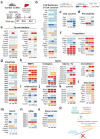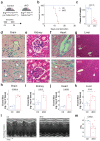Cooperative ETS Transcription Factors Enforce Adult Endothelial Cell Fate and Cardiovascular Homeostasis
- PMID: 36713285
- PMCID: PMC7614113
- DOI: 10.1038/s44161-022-00128-3
Cooperative ETS Transcription Factors Enforce Adult Endothelial Cell Fate and Cardiovascular Homeostasis
Abstract
Current dogma dictates that during adulthood, endothelial cells (ECs) are locked in an immutable stable homeostatic state. By contrast, herein we show that maintenance of EC fate and function are linked and active processes, which depend on the constitutive cooperativity of only two ETS-transcription factors (TFs) ERG and Fli1. While deletion of either Fli1 or ERG manifest subtle vascular dysfunction, their combined genetic deletion in adult EC results in acute vasculopathy and multiorgan failure, due to loss of EC fate and integrity, hyperinflammation, and spontaneous thrombosis, leading to death. ERG and Fli1 co-deficiency cause rapid transcriptional silencing of pan- and organotypic vascular core genes, with dysregulation of inflammation and coagulation pathways. Vascular hyperinflammation leads to impaired hematopoiesis with myeloid skewing. Accordingly, enforced ERG and FLI1 expression in adult human mesenchymal stromal cells activates vascular programs and functionality enabling engraftment of perfusable vascular network. GWAS-analysis identified vascular diseases are associated with FLI1/Erg mutations. Constitutive expression of ERG and Fli1 uphold EC fate, physiological function, and resilience in adult vasculature; while their functional loss can contribute to systemic human diseases.
Conflict of interest statement
Competing Interest Statement: Shahin Rafii is the co-founder and non-paid consultant to Angiocrine Bioscience, CA.
Figures


















References
-
- Gomez-Salinero JM, Rafii S. Endothelial cell adaptation in regeneration. Science. 2018;362:1116–1117. - PubMed
Grants and funding
LinkOut - more resources
Full Text Sources
